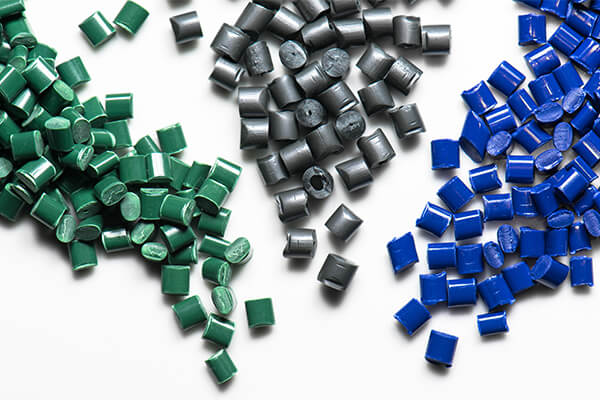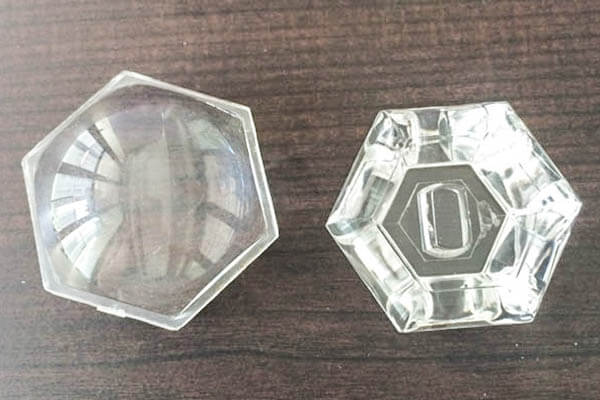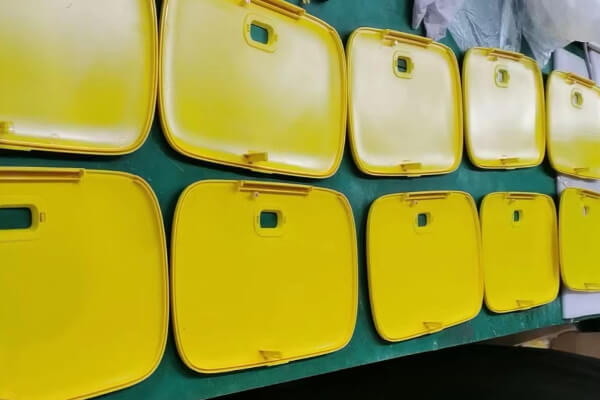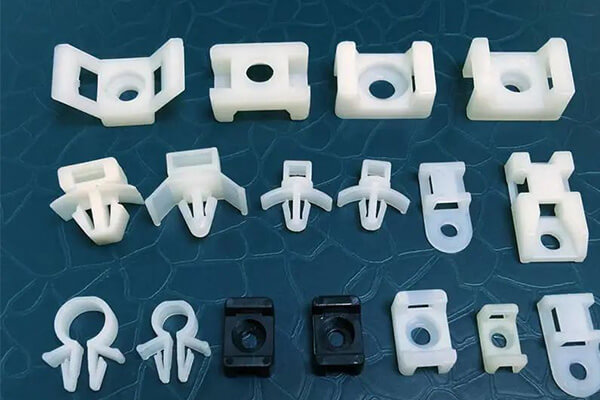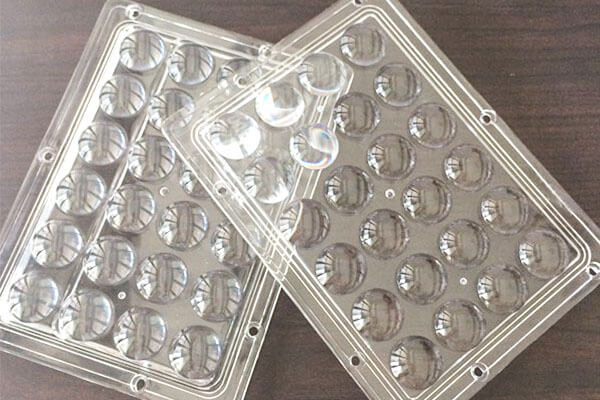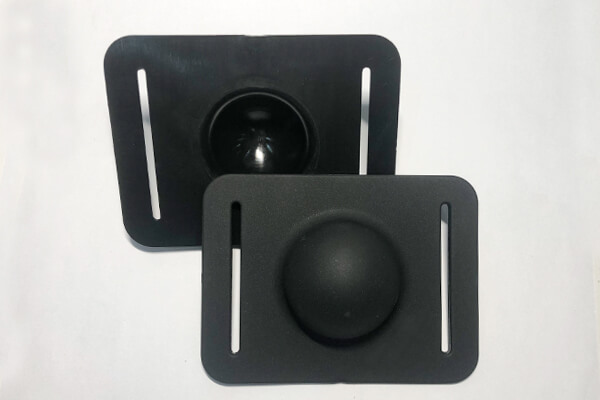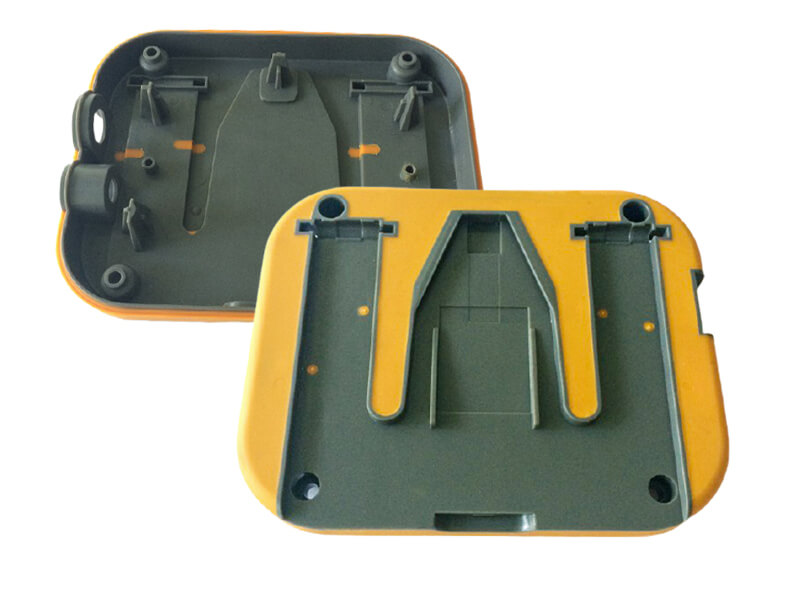Common 15 Injection Molding Plastics and Modified Plastics
Many common injection molding plastics are used in injection molding. Each injection molded plastics has different properties and features suited for different productions and applications. There are lots of injected molded plastic, for your options, such as modified plastics and thermoplastic. Sungplastic will introduce them to help your projects.
The Top 15 Injection Molding Plastics
The most commonly used top 15 injection molding plastics including: PMMA, ABS, PA, PC, PE, POM, PP, PS, TPE, TPU, TPR, PEEK, PEI, PET,PETG. Next, we will master the knowledge of these plastic injection molding materials.
Acrylic
Acrylic, also known as PMMA, is a versatile and widely used thermoplastic known for its strength, clarity, and lightweight properties. This injection molding plastic offers a shatter-resistant alternative to glass and provides excellent optical clarity, allowing a high percentage of light to pass through. Acrylic exhibits resistance to ultraviolet (UV) light and weather conditions, making it suitable for various applications, both indoors and outdoors.
1. Properties
Acrylic possesses several key properties that make it a popular choice in various industries. It has the ability to withstand exposure to water and maintains tight tolerances, ensuring dimensional stability. However, acrylic is not resistant to solvents and is prone to staining when exposed to greases and oils. Despite its high tensile strength, heavy loads may lead to stress cracking in injection-molded acrylic parts.
2. Applications
Acrylic’s unique combination of properties makes it well-suited for a wide range of applications. In the construction and architectural industries, it is commonly used for windows, providing clarity and durability. Greenhouses and solar panels benefit from its light transmission capabilities, allowing sunlight to pass through while protecting the interior. Acrylic is also utilized in bathroom enclosures, where its shatter-resistant nature is an advantage. Moreover, the lighting industry utilizes acrylic for transparent components to ensure optimal light dispersion and clarity.
3. Grades and Brands
Different grades of PMMA plastics are available, catering to specific application requirements. Some notable grades and brands include:
General-purpose acrylic: Widely used in commodity products and general applications.
Sign-grade acrylic: Specially formulated for outdoor signage, offering enhanced strength and excellent light transmission properties.
Marine-grade acrylic: Designed to resist continuous exposure to water, making it suitable for marine applications.
Several well-known brands produce high-quality acrylic plastics. For example, Trinseo PLEXIGLAS® offers acrylic sheets with high heat resistance, making them suitable for specific high-temperature applications. DuPont LUCITE® is recognized for its excellent optical clarity and transparency, ensuring exceptional visual performance in various products.
ABS (Acrylonitrile Butadiene Styrene)
Acrylonitrile Butadiene Styrene, commonly known as ABS, is a popular thermoplastic known for its ease of molding and versatile properties. Its unique combination of characteristics makes it suitable for various applications across different industries. ABS is renowned for its toughness, impact resistance, and attractive surface finish, making it a favored choice for injection molding projects.
1. Properties
ABS is valued for its relatively low melting point, which makes it easy to mold into intricate shapes. Its opaque nature allows for the use of colorants, and various textures and surface finishes can be achieved during the molding process. The butadiene content imparts exceptional toughness, ensuring durability even at low temperatures. Additionally, the styrene content contributes to a shiny, visually appealing finish in injection molded parts.
2. Applications
ABS finds widespread use in the manufacturing of plastic parts for various industries. It is commonly employed in the production of keyboard keys due to its ability to withstand repetitive use and impact. In the field of personal protection, ABS is used for manufacturing protective headgear, offering a balance of strength and lightweight design. Electrical outlet wall plates made from ABS ensure reliable and long-lasting electrical installations. The automotive industry utilizes ABS for manufacturing wheel covers due to its impact resistance and design flexibility. In consumer goods, ABS is employed for items like household appliances and electronic casings. It is also prevalent in the production of sports equipment and various industrial fittings.
3. Grades and Brands
ABS is available in different grades, each tailored to specific application requirements. Some well-known brands of ABS include:
Samsung Starex®: Known for its consistent quality and performance in various applications.
Toray Toyolac®: Offers a range of ABS grades suitable for different industries, ensuring excellent mechanical properties.
BASF Terluran®: Provides ABS with outstanding surface aesthetics and good processability.
Ineos Lustran®: Offers a wide variety of ABS grades with high impact resistance and excellent dimensional stability.
Nylon Polyamide (PA)
Nylon, a versatile synthetic polyamide (PA), is renowned for its exceptional combination of toughness, high heat resistance, and superior abrasion resistance. This engineering plastic offers a wide array of properties, including good fatigue resistance and effective noise-dampening capabilities. Though not inherently flame-resistant, flame-retardant versions are available, and outdoor performance can be enhanced with the addition of UV stabilizers.
1. Properties
Nylon stands apart from other plastics due to its remarkable toughness and ability to withstand high temperatures. Its resistance to abrasion makes it ideal for applications subject to wear and tear. However, nylon exhibits poor resistance to strong acids and bases, setting it apart from other materials like polypropylene. Another limitation is its lower impact resistance compared to polycarbonate. During injection molding, nylon can present challenges due to its tendency to shrink, potentially leading to inadequate mold filling.
2. Applications
Nylon’s exceptional mechanical properties make it well-suited for various applications in different industries. It is commonly used in the production of strong mechanical parts, such as bearings, bushings, gears, and slides, where durability and resilience are essential. Nylon’s reliability and strength also make it a popular choice for casings and snap-fit closures in electronic and automotive components. In industries requiring threaded inserts and kinetic parts, nylon’s versatility shines. Additionally, jigs and fixtures benefit from nylon’s toughness and stability, enhancing their overall performance. The low coefficient of friction in nylon makes it an excellent choice for applications where high friction and wear are prevalent.
3. Grades and Brands
Nylon is available in several grades, each tailored to specific requirements in various applications. Some notable nylon grades and their distinctive properties include:
Nylon 11: Ideal for outdoor applications due to its greater resistance to dimensional changes, offering reliability and stability even in challenging environments.
Nylon 12: Known for its low melting point and resistance to water absorption, making it suitable for applications where moisture resistance is crucial.
Nylon 46: Boasting the highest operating temperature among the four grades, Nylon 46 is well-suited for applications requiring high-temperature resistance.
Nylon 66: With a high melting point and strong resistance to acids used in chemical processing, Nylon 66 is a preferred choice for demanding chemical environments.
Moreover, nylon can be enhanced by incorporating glass fibers, further augmenting its mechanical strength for applications requiring added robustness and durability.
Polycarbonate (PC)
Polycarbonate (PC) is a robust and lightweight molded plastic known for its natural transparency. Its excellent optical properties facilitate light transmission, while its color can be retained or altered through pigmentation. Despite lacking scratch resistance, polycarbonate surpasses glass in strength and durability, making it a preferred choice for various applications.
1. Properties
When it comes to injection molding, polycarbonate offers significant advantages over other materials, such as maintaining its physical properties across a broader temperature range. However, the high processing temperatures required for molding may lead to increased production costs. Nevertheless, the predictable and uniform shrinkage of polycarbonate ensures precise dimensional control, allowing for tighter tolerances in the final product.
2. Applications
Polycarbonate’s exceptional properties make it a popular material for injection molding in a wide range of applications. Some key areas where polycarbonate is extensively used include:
- Machinery Guards: Due to its robustness and impact resistance, polycarbonate is utilized to produce protective guards for various machinery, ensuring safety and longevity.
- Clear and Tinted Windows: Polycarbonate finds use in manufacturing transparent windows for different industries, providing both clarity and resilience.
- Diffusers and Light Pipes for LEDs: The optical properties of polycarbonate make it suitable for producing diffusers and light pipes, effectively distributing light in LED applications.
- Clear Molds for Urethane and Silicone Casting: Polycarbonate’s transparency makes it an ideal choice for creating molds used in urethane and silicone casting processes.
It’s essential to note that polycarbonate contains bisphenol A (BPA), which raises concerns about its use in food preparation or storage applications.
3. Grades and Brands
Polycarbonate plastic comes in various grades, tailored to specific requirements in different applications. Some widely recognized brands offering polycarbonate materials include:
SABIC Lexan®: Known for its flame-resistant versions, SABIC Lexan® is a trusted choice for applications demanding high fire resistance and reliability.
Covestro Makrolon®: Covestro’s Makrolon® brand is distinguished by its glass-like transparency, providing exceptional optical clarity in various products and components.
Polyethylene (PE)
Polyethylene (PE) holds the distinction of being the most widely used plastic worldwide. It is a versatile commercial polymer that can be selected based on its density, leading to variations in properties and applications. High-density polyethylene (HDPE) and low-density polyethylene (LDPE) are two common types, each offering unique characteristics in terms of hardness, flexibility, melting point, and optical transparency.
1. Properties
PE plastics encompass various materials, including polyethylene terephthalate (PET, PETE), which is not categorized solely by density. PET shares similarities with LDPE in terms of its glass-like clarity, but designers can choose specific grades with varying optical clarity levels. HDPE, LDPE, and PET all exhibit resistance to moisture and chemicals, though LDPE stands out for its softer, more flexible nature compared to the opaque HDPE.
2. Applications
Polyethylene injection molding finds extensive use in a wide range of applications, although some limitations exist due to UV resistance and service temperature constraints. Typically, polyethylene is preferred for indoor applications, and its usage extends to various products, including:
- Housewares: Injection-molded polyethylene finds its way into household items due to its durability and cost-effectiveness, contributing to the production of containers, utensils, and storage solutions.
- Toys: The flexibility and molding capabilities of polyethylene make it a popular choice for manufacturing various toys, ensuring safety and fun for children.
- Food Containers: Its resistance to moisture and chemicals make polyethylene a viable option for food-grade containers, promoting safe and hygienic storage.
- Automotive Parts: In the automotive industry, polyethylene injection molding plays a vital role in producing components like automotive interiors and exterior parts.
3. Grades and Brands
PE plastics are classified into numbered grades, with higher numbers generally indicating higher densities. For instance, HDPE 500 possesses a higher density than HDPE 300. Similarly, LDPE utilizes a numbering system for its grades. Notably, BASF and DuPont are prominent suppliers of PE materials, particularly for engineering applications, emphasizing their commitment to quality and innovation.
Polyoxymethylene (POM)
Polyoxymethylene (POM), also known as acetal, is a highly versatile engineering plastic renowned for its excellent rigidity, thermal stability, and low coefficient of friction. Its unique properties make it a preferred choice for various applications where high mechanical performance and low friction are crucial. POM plastics naturally exhibit an opaque and white appearance.
1. Properties
In its pure form, POM may have relatively low impact strength and a high rate of thermal expansion. However, the material can be reinforced with fiberglass or minerals to enhance its strength and stiffness. The combination of both reinforcements results in an optimal balance of mechanical properties, making it suitable for a wide range of applications. Nevertheless, it is important to note that injected molded POM lacks resistance to sunlight, which limits its outdoor usage.
2. Applications
Injection-molded POM finds extensive application in numerous industries due to its outstanding properties. Some key applications include:
- Bearings: POM’s low coefficient of friction makes it an ideal material for manufacturing bearings, ensuring smooth and efficient rotational movements.
- Gears: POM’s excellent rigidity and low friction make it well-suited for producing gears used in various mechanical systems.
- Conveyor Belts: Its low friction characteristics make POM an excellent choice for conveyor belt systems, reducing wear and enhancing efficiency.
- Pulley Wheels: POM’s combination of stiffness and low friction is advantageous for creating pulley wheels used in mechanical systems.
- Fasteners: The durability and stability of POM make it suitable for producing fasteners used in various applications.
- Eyeglass Frames: POM’s lightweight nature and good mechanical properties make it a preferred material for manufacturing eyeglass frames.
- Knives and Firearms: POM’s excellent mechanical strength and wear resistance are advantageous for crafting parts in knives and firearms.
- Lock Systems: POM’s low coefficient of friction is beneficial for lock systems, ensuring smooth operation and longevity.
- High-Performance Engineering Components: POM is widely used in creating high-performance engineering components that require both mechanical strength and low friction.
3. Grades and Brands
Polyoxymethylene is available in two main types: homopolymers and POM copolymers. Homopolymers offer higher hardness and tensile strength, while POM copolymers provide a balance of properties suitable for specific applications. It is important to note that neither type of material can be fire-rated to a standard such as UL 94, and both experience relatively high shrinkage during injection molding. Some well-known brand names for POM plastics are DuPont Delrin® and Ensinger TECAFORM®, which are renowned for their consistent quality and performance in engineering applications.
Polypropylene (PP)
Polypropylene (PP) ranks as the second most commonly used plastic globally, known for its widespread applicability and advantageous properties. As an injection-molded material, PP offers good chemical resistance, shape retention after torsion or bending, a high melting point, and remarkable resistance to moisture and water exposure. Additionally, being recyclable further enhances its appeal in sustainable practices.
1. Properties
Polypropylene exhibits several notable properties that contribute to its popularity. It boasts excellent chemical resistance, making it suitable for various environments and applications that involve contact with different substances. PP’s ability to retain its shape even after torsion or bending provides durability and stability in diverse settings. With a high melting point, PP remains stable under elevated temperatures, expanding its application range. However, it is crucial to note that PP is susceptible to degradation when exposed to UV light and is highly flammable. When PP reaches temperatures above 100°C (212°F), it dissolves into aromatic hydrocarbons, such as benzene and toluene, which pose health hazards to humans. Additionally, bonding and painting PP can be challenging due to its unique chemical properties.
2. Applications
The versatility of polypropylene makes it a preferred choice for numerous injection molding applications, including:
- Toys: PP is commonly used to manufacture toys due to its safety, durability, and ease of molding into various shapes.
- Storage Containers: PP’s resistance to chemicals and moisture makes it ideal for producing storage containers for different purposes.
- Sporting Goods: PP’s lightweight and durable nature find application in various sporting goods, such as equipment and gear.
- Packaging: PP’s excellent barrier properties and formability make it a popular choice for packaging materials.
- Appliances: PP is utilized in manufacturing components and casings for appliances due to its resistance to heat and moisture.
- Power Tool Bodies: The toughness and resilience of PP make it suitable for creating power tool bodies that can withstand mechanical stress.
3. Grades and Brands
Polypropylene is available in various grades to suit specific requirements. Two significant types are:
Pure Polypropylene: Known as a commodity plastic with the lowest density, it is widely used for general applications where cost-effectiveness is crucial.
High Crystalline Polypropylene (HcPP): This variant incorporates glass fibers to enhance its rigidity, making it suitable for applications that demand higher mechanical strength.
Semitron® from Mitsubishi Chemical Advanced Materials is a well-known brand, offering high-quality polypropylene materials designed to meet specific industry demands and performance standards.
Polystyrene (PS)
Polystyrene (PS) is a widely used plastic known for its lightweight nature, cost-effectiveness, and resistance to moisture and bacterial growth. It offers excellent chemical resistance to diluted acids and bases, making it suitable for various applications. PS also exhibits remarkable resistance to gamma radiation, making it a preferred choice for medical devices that require sterilization.
1. Properties
Two main types of polystyrene are available:
- General-Purpose Polystyrene (GPPS): GPPS is known for its brittle nature and relatively lower dimensional stability. Despite this, it offers a glass-like clarity that makes it ideal for applications where transparency is required.
- High-Impact Polystyrene (HIPS): HIPS is compounded with butadiene rubber to enhance its material properties, providing higher impact strength and improved toughness compared to GPPS. HIPS is opaque and offers better dimensional stability.
2. Applications
Polystyrene injection molding finds diverse applications in various industries, including:
- Medical: Polystyrene is used in medical applications due to its resistance to gamma radiation, making it suitable for sterilizable medical devices.
- Optical: The clarity of GPPS makes it suitable for optical components, such as lenses and protective covers.
- Electrical and Electronic: PS is used in electrical and electronic applications for its insulation properties and cost-effectiveness.
- Appliances and Equipment: HIPS is commonly used in appliances and equipment due to its higher impact strength and toughness.
- Plastic Toys: Injection-molded GPPS is favored for manufacturing plastic toys, offering an economical and lightweight solution.
- Cases and Containers: Both GPPS and HIPS find use in creating cases, containers, and trays due to their lightweight and easy molding characteristics.
3. Grades and Brands
Polystyrene can be tailored to specific requirements through various grades and co-polymerization. Two popular brands are:
American Styrenics PolyRenew®: This brand offers polystyrene materials designed to promote recycling and sustainability initiatives.
BASF Polystyrol®: BASF provides high-quality polystyrene products suitable for a wide range of applications, including co-polymerized variants for enhanced properties like improved chemical and UV stability.
Thermoplastic Elastomer (TPE)
Thermoplastic Elastomer (TPE) is a versatile material that blends the properties of both plastic and rubber. Also known as thermoplastic rubber (TPR), TPE can be processed like plastic but exhibits the elasticity and performance of rubber. TPE materials can be repeatedly stretched to moderate elongations, and upon the release of stress, they return to their original shape. This combination of plastic and rubber properties makes TPE a popular choice for various applications.
1. Properties
TPE offers several distinctive properties, including:
- Ease of Molding: TPE is easier and less expensive to mold compared to liquid silicone rubber (LSR), offering cost-effective solutions for manufacturers.
- Elasticity and Flexibility: TPE materials exhibit rubbery properties, making them highly elastic and flexible, providing excellent sealing and shock absorption capabilities.
- Creep Resistance: While TPEs can withstand moderate elongations, they are susceptible to creep, which is the permanent deformation of a solid material under sustained pressure.
- Temperature Sensitivity: TPE tends to lose its rubbery properties at higher temperatures, affecting its performance in high-temperature applications.
- Recyclability: TPE can be recycled multiple times, contributing to sustainable and eco-friendly practices.
2. Applications
TPE injection molding finds diverse applications in various industries, such as:
- Footwear: TPE is commonly used in the production of shoe soles and components, offering comfort and flexibility for footwear applications.
- Medical Devices: TPE materials are suitable for medical devices like breathing tubes, valves, catheters, and ventilation masks due to their elasticity and biocompatibility.
- Automotive Parts: TPE is used in automotive applications for weather seals and shock dust boots, providing reliable sealing and vibration dampening properties.
- Pet Products: TPE is employed in manufacturing pet toys and accessories for its durability and chew resistance.
3. Grades and Brands
TPE materials are categorized into generic classes defined by ISO 18064. Several manufacturers offer TPE products with specific properties, including:
Teknor Apex Telcar®: This brand provides a range of TPE materials suitable for various applications, including automotive, consumer goods, and more.
Kraiburg HIPEX®: Known for its high-quality TPE compounds, Kraiburg offers a wide selection of TPE grades tailored to specific industries and requirements.
Dynaflex™ from Avient (formerly PolyOne): Avient offers a diverse portfolio of TPE materials, including Dynaflex™, catering to applications in healthcare, consumer goods, and industrial sectors.
Healthcare-grade TPEs are also available, meeting specific regulatory requirements for medical applications.
Thermoplastic Polyurethane (TPU)
Thermoplastic Polyurethane (TPU) is a popular type of Thermoplastic Elastomer (TPE) that stands out due to its unique properties and wide range of applications. TPU exhibits a rubber-like elasticity and is often used as a substitute for hard rubber, thanks to its higher durometer. This injection-moldable material boasts excellent load-bearing capabilities and can withstand exposure to ozone, making it suitable for various demanding applications.
1. Properties
TPU offers a set of distinctive properties, setting it apart from other TPE materials:
- Superior Temperature and Chemical Resistance: TPU demonstrates remarkable resistance to extreme temperatures and various chemicals, enabling its use in challenging environments.
- High Durometer: TPU’s higher durometer makes it a viable alternative to hard rubber, providing increased hardness and rigidity.
- Cost and Processing: TPU tends to be costlier than standard TPE materials and requires a drying process before injection molding.
- Elasticity: Like other TPEs, TPU retains its rubber-like elasticity, providing flexibility and resilience to the final molded products.
2. Applications
TPU injection molding finds diverse applications across several industries:
- Footwear: TPU is extensively used in the footwear industry for producing shoe soles, providing optimal comfort and durability.
- Gaskets: TPU’s excellent sealing capabilities make it suitable for gaskets used in various applications, ensuring leak-free performance.
- Caster Wheels: TPU caster wheels offer smooth rolling and enhanced load-bearing capacity for a wide range of equipment.
- Sporting Goods: TPU is used to manufacture sporting goods such as protective gear, handles, and grips, delivering impact resistance and flexibility.
- Electronics and Medical Devices: TPU is employed to create cases or enclosures for electronics and medical devices, offering impact protection and chemical resistance. In medical applications, TPU is sometimes preferred over polyvinyl chloride (PVC) due to its skin-friendly nature.
3. Grades and Brands
Thermoplastic polyurethanes come in different grades based on their specific characteristics and applications. The main classes of TPU materials include:
Polyester-based TPUs: Offering excellent physical properties and abrasion resistance.
Polyether-based TPUs: Known for their superior hydrolytic stability and flexibility.
Polycaprolactone-based TPUs: Providing enhanced resistance to chemicals and low-temperature flexibility.
TPU materials are available from various manufacturers, with some well-known brands including:
Lanxess: Offers a comprehensive range of TPU products suitable for automotive, industrial, and consumer applications.
Lubrizol: Known for its innovative TPU solutions for diverse industries, including sports and recreation, electronics, and more.
Texin: Provides high-performance TPU grades with exceptional durability and processing characteristics.
Ultralast: Offers TPU materials tailored for specific applications, meeting stringent industry requirements.
These brands provide trademarked TPU products with a focus on commercial, medical, and industrial grades to cater to a wide array of applications.
Thermoplastic Rubber (TPR)
Thermoplastic Rubber (TPR) is a versatile material that combines the properties of both plastic and rubber, making it suitable for the injection molding process.
1. Properties
Its unique composition offers exceptional chemical and weather resistance along with high impact strength. Due to these advantageous characteristics, TPR finds application in various fluid dispensers, flexible hoses, catheters, and other components that come into contact with different liquids, including acidic substances. TPR is also commonly referred to as thermoplastic elastomer (TPE).
2. Application
TPR’s wide-ranging properties make it well-suited for diverse applications across different industries:
- Medical Catheters: TPR is used in medical catheters due to its excellent chemical resistance and flexibility, making it a reliable choice for safe and effective medical procedures.
- Suspension Bushings: In the automotive sector, TPR is employed in suspension bushings to dampen vibrations and reduce noise, enhancing overall ride comfort.
- Headphone Cables: TPR’s flexibility and durability make it an ideal material for headphone cables, ensuring reliable performance and extended product life.
3. Grades and Brands
TPR materials come in various grades, each tailored to specific applications and performance requirements. Brands offering high-quality TPR products include:
Kraton: Kraton is a well-known supplier of TPR materials, offering a wide range of grades suitable for applications in automotive, consumer goods, and medical industries.
Kraiburg TPE: This brand provides innovative TPR solutions with customizable properties to meet specific customer needs.
Teknor Apex: Teknor Apex offers a diverse portfolio of TPR compounds for various applications, including electronics, consumer goods, and industrial components.
These brands ensure consistent quality and reliability in their TPR products, making them essential materials for a broad spectrum of products in different sectors.
PEEK
PEEK (Polyetheretherketone) is a high-performance engineering thermoplastic known for its exceptional mechanical, thermal, and chemical properties. It belongs to the family of polyaryletherketones and is widely recognized for its versatility and reliability in various industries.
1. Properties
PEEK boasts an impressive set of properties, making it suitable for demanding applications. Some key properties of PEEK include:
- High Temperature Resistance: PEEK can withstand continuous service temperatures of up to 260°C (500°F) without significant degradation.
- Excellent Mechanical Strength: It exhibits high tensile strength, fatigue resistance, and creep resistance, ensuring long-term durability.
- Chemical Resistance: PEEK demonstrates resistance to a wide range of chemicals, making it suitable for aggressive environments.
- Low Flammability: PEEK is inherently flame-resistant, offering added safety in applications with exposure to heat or flames.
- Hydrolysis Resistance: It maintains its mechanical properties even in the presence of steam or hot water.
- Low Outgassing: PEEK exhibits minimal outgassing, making it suitable for aerospace and vacuum applications.
2. Applications
PEEK finds extensive use in diverse applications across various industries. Some notable applications include:
- Aerospace: PEEK is used in aircraft components due to its lightweight nature, strength, and resistance to high temperatures.
- Medical: It is utilized in medical implants and instruments, thanks to its biocompatibility and excellent sterilization properties.
- Automotive: PEEK is applied in automotive components, such as bearings and seals, due to its durability and resistance to wear.
- Oil and Gas: PEEK’s chemical and temperature resistance make it suitable for downhole drilling equipment and other oil and gas applications.
- Electronics: PEEK is used in electrical connectors and insulators due to its excellent dielectric properties.
3. Grades and Brands
PEEK is available in various grades tailored to specific applications. Some popular brands offering high-quality PEEK materials include Victrex® PEEK, Solvay KetaSpire®, and Evonik VESTAKEEP®. Each brand may offer specialized variants of PEEK with additional modifications to suit particular industry requirements.
PEI (Polyetherimide)
PEI, or Polyetherimide, is a high-performance thermoplastic known for its exceptional mechanical, thermal, and electrical properties. It belongs to the family of amorphous engineering polymers and is widely used in industries where strength, heat resistance, and dimensional stability are critical.
1. Properties
PEI offers a unique combination of properties that make it stand out among other engineering plastics. Key properties of PEI include:
- High Temperature Resistance: PEI can withstand continuous use at elevated temperatures up to 170°C (338°F) without losing its mechanical properties.
- Excellent Mechanical Strength: It exhibits high tensile strength and impact resistance, making it suitable for load-bearing applications.
- Flame Resistance: PEI is inherently flame-retardant, providing added safety in applications where fire resistance is crucial.
- Chemical Resistance: It shows resistance to a wide range of chemicals, ensuring long-term stability in aggressive environments.
- Dimensional Stability: PEI maintains its shape and dimensions even at high temperatures, making it suitable for precision components.
- Electrical Insulation: PEI possesses excellent electrical insulating properties, making it suitable for electrical and electronic applications.
2. Applications
PEI finds extensive applications in various industries due to its exceptional properties. Some notable applications include:
- Aerospace: PEI is used in aircraft components like interior panels, connectors, and brackets due to its high strength and flame resistance.
- Medical: It is utilized in medical instruments, sterilization trays, and surgical devices owing to its biocompatibility and chemical resistance.
- Electronics: PEI is used in electrical connectors, coil bobbins, and insulators due to its electrical insulating properties.
- Automotive: It is applied in automotive components, such as sensors, connectors, and fuel system parts, due to its high temperature resistance.
- Industrial: PEI is used in various industrial applications, including valve components, pump housings, and gears.
3. Grades and Brands
PEI is available in different grades tailored for specific applications. Popular brands offering high-quality PEI materials include SABIC ULTEM®, Quadrant Ketron® PEI, and RTP Company EMI-Shielded PEI. Each brand may offer specialized variants of PEI with additional modifications to meet specific industry requirements.
PET (Polyethylene Terephthalate)
PET, short for Polyethylene Terephthalate, is a widely used thermoplastic polymer known for its versatility and numerous applications. It is a member of the polyester family and is commonly used for its excellent combination of properties, including clarity, toughness, and recyclability.
1. Properties
PET exhibits several key properties that contribute to its popularity and extensive use:
- Transparency: PET is highly transparent, making it an ideal choice for packaging applications where product visibility is crucial.
- Lightweight: PET is lightweight, which reduces transportation costs and makes it suitable for various consumer goods.
- Mechanical Strength: Despite its lightweight nature, PET maintains good mechanical strength, ensuring the integrity of containers and bottles.
- Chemical Resistance: It offers excellent resistance to water, acids, and bases, making it suitable for various liquid storage applications.
- Food-Grade Material: PET is approved as a food-contact material, ensuring its safe use in the packaging of food and beverages.
- Recyclability: PET is widely recycled and can be used to produce various products, promoting sustainability and environmental responsibility.
2. Applications
PET is utilized in a wide range of applications across different industries, owing to its desirable properties. Some common applications of PET include:
- Beverage Bottles: PET bottles are extensively used for packaging water, carbonated drinks, juices, and other beverages.
- Food Containers: PET containers are employed for packaging various food items, including sauces, dressings, and condiments.
- Textile Fibers: PET is used to produce polyester fibers for clothing and other textiles due to its strength and durability.
- Film and Sheets: PET films find use in packaging, graphics, and printing applications due to their transparency and versatility.
- Medical Applications: PET is used in medical devices and equipment, such as surgical sutures and medical imaging products.
3. Grades and Brands
PET is available in different grades, each catering to specific applications. Common brands offering PET materials include Eastman’s Eastar®, Indorama Ventures Polyclear®, and M&G Chemicals Invista Polyclear®. These brands may offer specialized PET variants with tailored properties for specific industries and requirements.
PETG
PETG, short for Polyethylene Terephthalate Glycol, is a transparent thermoplastic that combines the advantages of both PET (Polyethylene Terephthalate) and glycol modification. This unique blend results in a versatile material known for its clarity, toughness, and ease of processing. PETG is widely used in various industries due to its excellent balance of properties.
1. Properties
PETG possesses a set of desirable properties that make it a popular choice for numerous applications. Some key properties of PETG include:
- Transparency: PETG offers excellent optical clarity, making it suitable for applications that require visibility and transparency.
- Impact Resistance: It exhibits high impact strength, making it more robust and less prone to cracking or breaking compared to regular PET.
- Chemical Resistance: PETG resists chemical exposure, providing durability in various environments.
- FDA-Compliant: It is approved for food contact applications, ensuring safety in packaging and food-related products.
- Recyclability: PETG is recyclable, making it an environmentally friendly choice for sustainable packaging solutions.
2. Applications
PETG finds widespread use in different industries, thanks to its versatility and favorable properties. Some common applications of PETG include:
- Packaging: PETG is extensively used for food and beverage packaging, as well as for cosmetic containers and blister packaging.
- Medical: It is employed in medical device components, such as syringes, vials, and IV containers, due to its excellent biocompatibility and sterilization properties.
- Displays: PETG is often utilized in point-of-purchase displays, signage, and protective screens, owing to its transparency and impact resistance.
- Consumer Goods: PETG is found in various consumer products like water bottles, household containers, and personal care items.
- 3D Printing: PETG is a popular material in 3D printing due to its ease of printing, dimensional stability, and toughness.
3. Grades and Brands
PETG is available in different grades tailored to specific applications and processing methods. Several reputable brands offer PETG materials, including Eastman Tritan™, Evonik VIVAK®, and PolyOne reSound®. Each brand may offer variations of PETG with specific additives or modifications to suit particular requirements in different industries.
Modified Injection Molding Plastics
Modified injection molding plastics, also known as engineered or specialty plastics, are plastic materials that have been chemically altered or processed to improve specific properties or characteristics. These modifications are done to enhance the performance, durability, or functionality of the base plastic, making it better suited for particular applications.
The modifications can be achieved through various techniques, such as compounding, blending, or chemical treatments. Some common methods for modifying plastics include:
- 1. Additives: Adding different additives to the plastic matrix can enhance properties like UV resistance, flame retardancy, impact strength, flexibility, and heat resistance. Examples of additives include fillers, reinforcements (e.g., fiberglass), plasticizers, stabilizers, and colorants.
- 2. Alloying: Blending two or more different plastics together can create an alloy with a combination of their individual properties. This process can lead to improved mechanical properties, better chemical resistance, or unique appearance characteristics.
- 3. Crosslinking: Introducing chemical bonds between polymer chains can create a crosslinked or network structure, increasing the material’s strength, heat resistance, and dimensional stability.
- 4. Composites: Combining plastics with other materials like fibers, nanoparticles, or ceramics can produce composite materials with improved strength, stiffness, and specific performance attributes.
- 5. Coatings: Applying specialized coatings to the surface of plastics can enhance properties such as scratch resistance, water repellency, or chemical resistance.
Modified injection molding plastics find applications in a wide range of industries, including automotive, aerospace, electronics, medical devices, and consumer goods. They offer tailored solutions for specific requirements, enabling manufacturers to optimize their products’ performance and efficiency. However, it’s essential to consider the environmental impact of modified plastics, especially in terms of recycling and waste management, to ensure sustainability in their usage.
Additives and Fillers for Injection Molding Plastics
Additives and fillers are materials that are incorporated into plastic formulations during the processing of polymers. These substances are added to modify and enhance the properties of the base plastic, making it more suitable for specific applications. Here’s more information about additives and fillers.
Additives for Injection Molding Plastics
Additives are chemical compounds that are blended into the plastic matrix in small quantities (typically less than 5% by weight) to alter specific properties. There are various types of additives, and each serves a particular purpose. Some common types of additives include:
- Stabilizers: Stabilizers are used to protect plastics from degradation caused by heat, UV radiation, or oxidation, thus increasing their lifespan.
- Plasticizers: These additives increase the flexibility and durability of plastics by reducing their glass transition temperature and enhancing their processing characteristics.
- Flame Retardants: Flame retardant additives reduce the flammability of plastics, making them safer in applications where fire resistance is crucial.
- Antioxidants: Antioxidants prevent the oxidation of plastics, helping to maintain their mechanical properties and appearance over time.
- Colorants: Colorants are additives that provide pigmentation to plastics, allowing manufacturers to create products in various colors.
- Lubricants: Lubricants enhance the flow of plastics during processing, reducing friction and improving mold release.
- Antistatic Agents: Antistatic additives help reduce static electricity buildup on the surface of plastics, making them less likely to attract dust and dirt.
- Foaming Agents: Foaming agents create a cellular structure within the plastic, reducing density, and increasing thermal and acoustic insulation.
Additives are essential for achieving desired performance characteristics and ensuring the longevity of plastic products in various industries, including automotive, packaging, electronics, and construction.
Fillers for Injection Molding Plastics
Fillers are inert materials that are added to plastic formulations to improve certain properties without significantly changing the polymer’s inherent characteristics.
Common types of fillers include:
- Glass Fiber: Glass fibers are commonly used to enhance the mechanical properties of plastics, such as tensile strength, stiffness, and impact resistance.
- Calcium Carbonate (CaCO3): CaCO3 is a widely used filler that can improve the hardness and rigidity of plastics while reducing material costs.
- Talc: Talc is used as a filler to improve the dimensional stability, stiffness, and heat resistance of plastics.
- Carbon Black: Carbon black is a filler and a pigment that enhances the UV resistance and electrical conductivity of plastics.
Fillers can also reduce shrinkage, improve dimensional stability, and help control thermal expansion in plastic products.The addition of fillers to plastics allows manufacturers to tailor materials for specific applications, ensuring they meet performance and cost requirements.
Both additives and fillers play crucial roles in the formulation of plastic materials, allowing manufacturers to create products with a wide range of properties and characteristics to suit diverse application needs.
Considerations for Material Properties
Plastic injection molding materials properties determine how a material will perform under various conditions, affecting its suitability for different uses. Engineers and designers carefully assess these properties to ensure the chosen material meets the requirements of the intended application.
- 1. Mechanical Properties
Mechanical properties encompass a range of characteristics that describe how a material responds to mechanical forces. Key mechanical properties include:
Strength: The ability of a material to withstand applied forces without deformation or failure.
Toughness: The ability to absorb energy before fracture or failure.
Hardness: The resistance of a material to indentation or scratching.
Elasticity: The ability of a material to return to its original shape after deformation.
- 2. Thermal Properties
Thermal properties dictate a material’s behavior in response to temperature changes. Important thermal properties include:
Melting Point: The temperature at which a solid material transforms into a liquid.
Thermal Conductivity: The ability to conduct heat.
Coefficient of Thermal Expansion: The change in dimension due to temperature variations.
- 3. Electrical Properties
Electrical properties are crucial in applications where materials are used as conductors or insulators. Essential electrical properties include:
Electrical Conductivity: The ability to carry an electric current.
Dielectric Strength: The ability to withstand electric fields without breaking down.
Resistivity: The measure of a material’s opposition to the flow of electric current.
- 4. Chemical Resistance
Chemical resistance refers to a material’s ability to resist degradation or corrosion when exposed to various chemicals. Different materials have varying degrees of chemical resistance, making it vital to select the appropriate material for the specific environment.
- 5. Environmental Considerations
Environmental factors can significantly impact material performance. Considerations may include:
UV Resistance: Some materials are susceptible to degradation when exposed to ultraviolet radiation, affecting their suitability for outdoor applications.
Moisture Absorption: The ability of a material to absorb moisture, which can lead to dimensional changes and mechanical property variations.
- 6. Optical Properties
In applications that require transparency or light transmission, optical properties are essential. Key optical properties include:
Transparency: The ability of a material to allow light to pass through without significant distortion.
Refractive Index: Determines how light bends as it passes through the material.
Consult with us: The Right Injection Molding Plastics For Your Project
As a custom injection molding manufacturer, Sungplastic can provide a series of injection molding plastics for your options.
In the injection molding industry, we have worked hard for many years, have a deep understanding of the industry, have high-quality team members, multiple automated flow production lines, and many large-scale injection molding machines. We have rich technical knowledge, mature production and manufacturing technology, and provide professional customized services.
Please contact us about consulting and custom manufacturing services!
About Sungplastic
Sungplastic is a plastic product manufacturer with rich experience in injection molding. According to the different product development requirements, we flexibly adjust the manufacturing process to achieve high quality, high efficiency and more economical.
We offer a variety of manufacturing services: Rapid Prototyping, Tool Making, Injection Molding, Product Design and Development, CNC Machining and Metal Stamping. You can choose from a variety of plastics, silicone rubber, or metal for your product. Regardless of mass production or small batch customization, Sungplastic has always been committed to providing assured, efficient and more economical one-stop processing services for your projects.
Contact us for a free quote and project review.
Get a free quote and design analysis today.
We’ll reply you within 6 working hours.
We respect your privacy.
+86 139 2927 4777 (WhatsApp, Wechat)

